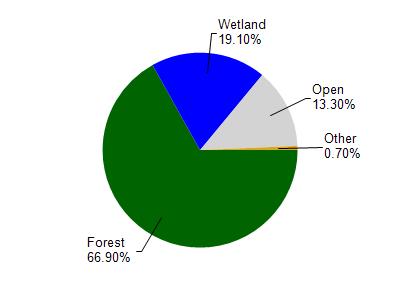Iron
No
No
No
Fish and Aquatic Life
Overview
Du Page Lake, in the Manitowish River Watershed, is a 31.15 acre lake that falls in Iron County. This lake is managed for fishing and swimming and is currently not considered impaired.
Date 2011
Author Aquatic Biologist
Historical Description
Source:1970, Surface Water Resources of Iron County,WI:WI-DNR Du Page Lake, T43N, R4E, Section 27
A very soft water seepage lake having slightly acid, light brown water of low transparency. Lake has an intermittent outlet and inlet. Muck is the predominant littoral material (55 percent), with sand (40 percent) and some gravel. Upland shoreline is dominant (55 percent), with the balance being wetland of the bog and meadow type with some conifer. A narrow fringe of wetland lies between portions of the upland and the lake basin. Largemouth bass, perch, bluegill, black crappie, and black bullhead inhabit this lake. Waterfowl may utilize this lake during their spring and fall migrations and for nesting. There is a sparse development of emergent vegetation. Two dwellings are located on the shoreline. The only means of public access is that of the wilderness type across state lands administered by the Division of Trust Lands and Investments. There is 0.45 mile of public frontage.
Surface Acres = 32.4, S.D.F. = 1.50, Maximum Depth = 31 feet
Date 1970
Author Surface Water Inventory Of Wisconsin
Condition
Wisconsin has over 84,000 miles of streams, 15,000 lakes and milllions of acres of wetlands. Assessing the condition of this vast amount of water is challenging. The state's water monitoring program uses a media-based, cross-program approach to analyze water condition. An updated monitoring strategy (2015-2020) is now available. Compliance with Clean Water Act fishable, swimmable standards are located in the Executive Summary of Water Condition in 2018. See also the 'monitoring and projects' tab.
Reports
Management Goals
Wisconsin's Water Quality Standards provide qualitative and quantitative goals for waters that are protective of Fishable, Swimmable conditions [Learn more]. Waters that do not meet water quality standards are considered impaired and restoration actions are planned and carried out until the water is once again fishable and swimmable
Management goals can include creation or implementation of a Total Maximum Daily Load analysis, a Nine Key Element Plan, or other restoration work, education and outreach and more. If specific recommendations exist for this water, they will be displayed below online.
Monitoring
Monitoring the condition of a river, stream, or lake includes gathering physical, chemical, biological, and habitat data. Comprehensive studies often gather all these parameters in great detail, while lighter assessment events will involve sampling physical, chemical and biological data such as macroinvertebrates. Aquatic macroinvertebrates and fish communities integrate watershed or catchment condition, providing great insight into overall ecosystem health. Chemical and habitat parameters tell researchers more about human induced problems including contaminated runoff, point source dischargers, or habitat issues that foster or limit the potential of aquatic communities to thrive in a given area. Wisconsin's Water Monitoring Strategy was recenty updated.
Grants and Management Projects
| Project Name (Click for Details) | Year Started |
|---|
|
|
Monitoring Projects
| WBIC | Official Waterbody Name | Station ID | Station Name | Earliest Fieldwork Date | Latest Fieldwork Date | View Station | View Data |
|---|
| 2325700 | DuPage Lake | 10002895 | Du Page Lake | 8/29/2000 | 9/21/2017 | Map | Data |
| 2325700 | DuPage Lake | 10019766 | Dupage Lake -- Access | | | Map | Data |
|

Watershed Characteristics
DuPage Lake is located in the Manitowish River watershed which is 268.60 mi². Land use in the watershed is primarily forest (66.90%), wetland (19.10%) and a mix of open (13.30%) and other uses (0.70%). This watershed has 212.08 stream miles, 22,943.16 lake acres and 33,727.48 wetland acres.
Nonpoint Source Characteristics
This watershed is ranked Low for runoff impacts on streams, Low for runoff impacts on lakes and Low for runoff impacts on groundwater and therefore has an overall rank of Low. This value can be used in ranking the watershed or individual waterbodies for grant funding under state and county programs.However, all waters are affected by diffuse pollutant sources regardless of initial water quality. Applications for specific runoff projects under state or county grant programs may be pursued. For more information, go to surface water program grants.